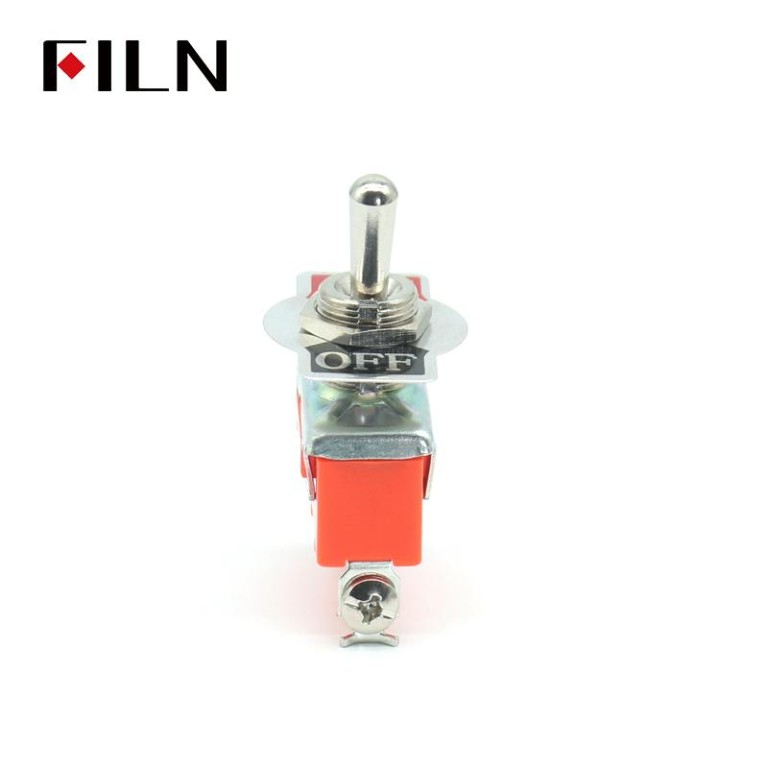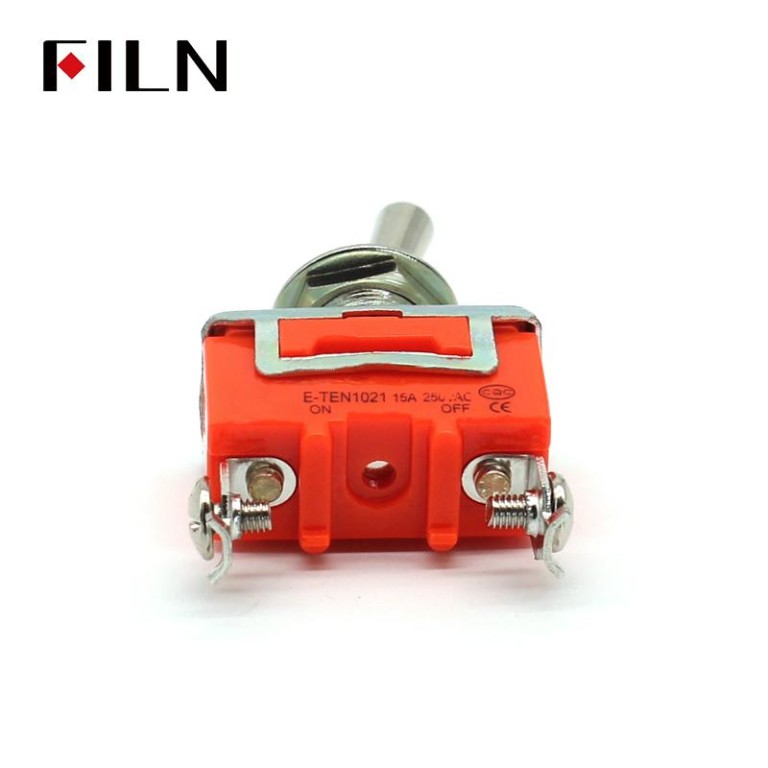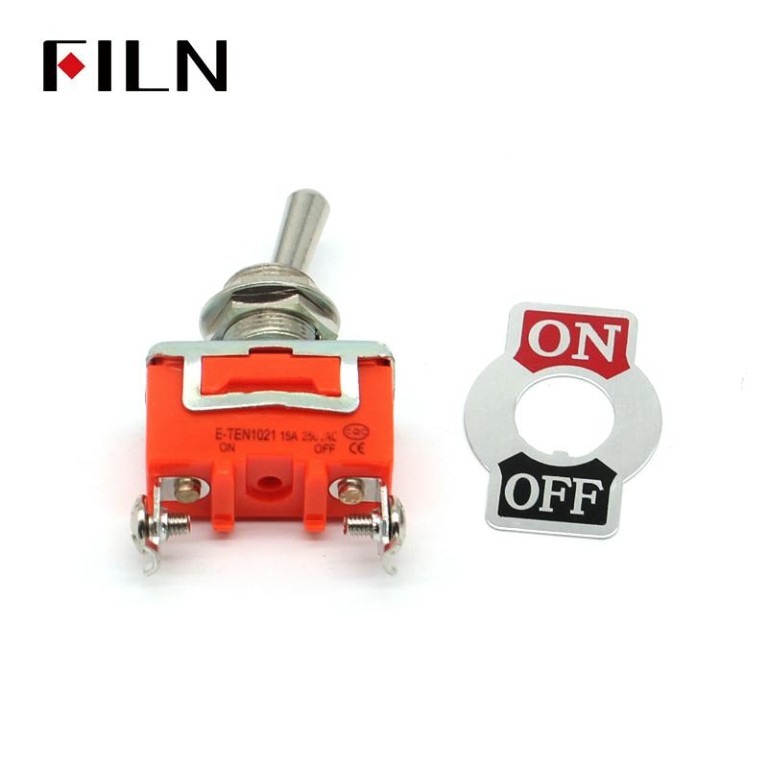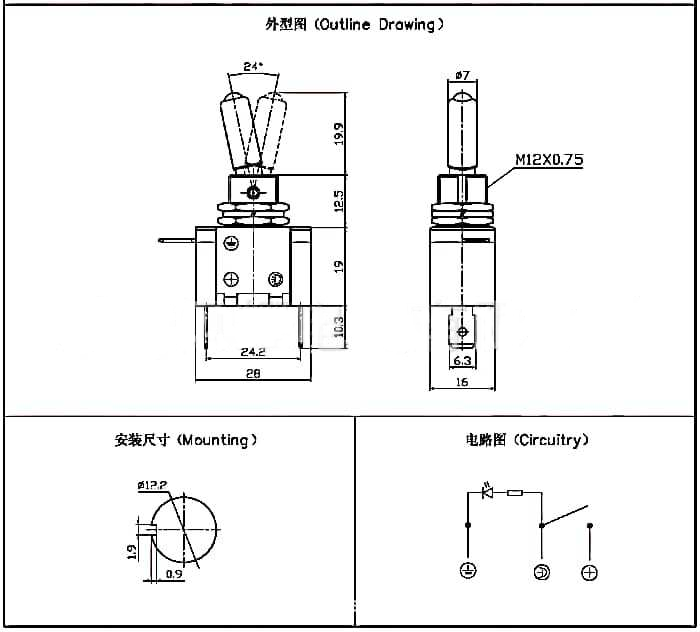Understanding SPDT Toggle Switch: A Comprehensive Guide
Understanding SPDT Toggle Switch: A Comprehensive Guide
- Model:2 prong 12v Toggle Switch
- Name:spdt toggle switch
- Working Voltage: < 250V
- Electric Current:20A
- Contact:Open/Closed
- Voltage:250V
- Life:50000 times
- Specifications: 2 pin 2 positions
- Email:inquiry@cnylin.com.cn
- Website:www.FILN.com
Discover the fascinating world of SPDT toggle switches in this comprehensive guide. Whether you’re a professional, hobbyist, or simply curious about SPDT switches, this article delves into everything you need to know. From understanding what an SPDT toggle switch is to exploring its various applications across different industries, wiring methods, common mistakes, and even choosing the right manufacturer – we’ve got you covered. Unravel the complexities and versatile uses of SPDT toggle switches and learn how to utilize them effectively and safely in various scenarios. This one-stop guide promises to enhance your understanding and equip you with the essential knowledge and insights, so keep reading!
Table of Contents
Step 1: Generate 10 of the most asked questions about SPDT Toggle Switch
1. What is an SPDT toggle switch, and how does it differ from other types of switches?
2. How do you wire an SPDT on-off-on toggle switch, and what is the wiring diagram?
3. What are the applications and examples of using an SPDT switch in various industries?
4. How does an SPDT momentary toggle switch work, and where is it commonly used?
5. What are the different types of SPDT toggle switches, including mini and 3PDT switches?
6. How can you select the right SPDT switch for your needs, considering factors like size, type, and functionality?
7. What are the considerations for installing and maintaining an SPDT mini toggle switch?
8. How does the toggle switch washer affect the performance and functionality of an SPDT switch?
9. What are the safety guidelines and best practices when working with SPDT on-off-on wiring diagrams and switches?
10. Where can you buy quality SPDT toggle switches, and what are some reputable brands?
Step 2: What is an SPDT toggle switch, and how does it differ from other types of switches?
Definition of SPDT Toggle Switch
An SPDT toggle switch, also known as a Single Pole Double Throw switch, is a type of switch with one input and two output channels. It differs from other switches by allowing the user to choose between two different output channels by toggling a lever or button.
Comparison with Other Switches
Compared to other types of switches like DPDT (Double Pole Double Throw), the SPDT toggle switch has fewer connection options, making it simpler in design and function. Check [indicatorlight.com](https://www.indicatorlight.com/category/toggle-switch/) for various types of switches.
Functionality of SPDT Switch
An SPDT switch can be utilized in a variety of applications where switching between two different circuits is necessary. It has a common terminal and two other terminals that correspond to the two different states of the switch.
Various Types and Materials
There are various types of SPDT toggle switches, such as rocker, slide, or push-button. Materials used can differ, including plastic, metal, or a combination of both, affecting durability and aesthetics.
Importance in Electronics
SPDT toggle switches are essential in electronic devices, enabling users to switch between different modes or settings. Their simple yet versatile design makes them suitable for numerous applications.
Availability and Brands
These switches are widely available through different vendors and in various brands. Ensuring quality and compatibility with your application is crucial when choosing the right switch.
Relationship with Synonyms
The terms like “SPDT momentary toggle switch,” “spdt on-off-on wiring diagram,” and “center off toggle switch wiring diagram” are related to different functions or specifications of an SPDT toggle switch, enriching its usability.
Use in Different Environments
SPDT toggle switches are adaptable and can be used in different environments, including industrial, automotive, or household applications. Their design allows for customization based on the specific needs of each environment.
Compliance with Standards
To ensure safety and reliability, SPDT toggle switches must comply with various international standards. Compliance ensures that the switch performs consistently and meets the required safety norms.
Step 3: How do you wire an SPDT on-off-on toggle switch, and what is the wiring diagram?
Introduction to Wiring an SPDT On-Off-On Toggle Switch
Wiring an SPDT on-off-on toggle switch might seem complex, but with proper knowledge and tools, it can be a straightforward task. Here’s a guide to understanding the wiring and implementing it safely.
Understanding the Terminals
An SPDT on-off-on toggle switch typically consists of three terminals: one common (C), one normally open (NO), and one normally closed (NC). The common terminal connects to the circuit, while the other two switch between open and closed states.
Wiring Diagram Explanation
An SPDT on-off-on wiring diagram illustrates how the connections are made between the terminals. The common terminal is connected to the power source, and the other two terminals are connected to the devices being controlled. More details can be found at [indicatorlight.com](https://www.indicatorlight.com/).
Tools and Materials Needed
Proper tools like wire strippers, soldering iron, and a multimeter, along with the correct gauge of wire, are crucial for wiring an SPDT on-off-on toggle switch. Quality materials ensure a reliable connection.
Step-by-Step Wiring Guide
1. Identify the Terminals: Determine the common, normally open, and normally closed terminals.
2. Prepare the Wires: Strip and tin the wires, preparing them for connection.
3. Connect the Common Terminal: Attach the common terminal to the power source.
4. Connect the Other Terminals: Attach the NO and NC terminals to the respective devices.
5. Secure the Connections: Solder or screw the connections securely.
6. Test the Switch: Use a multimeter to verify the connections and functionality.q
Step 4: What are the applications and examples of using an SPDT switch in various industries?
Wide Applications of SPDT Switch
The SPDT switch, with its versatile design and functionality, finds applications in various industries and domains. Its ability to switch between two different circuits makes it a valuable component in different settings.
Use in Home Appliances
SPDT switches are commonly found in home appliances like fans, lighting systems, or washing machines, allowing users to switch between different modes or speeds.
Automotive Applications
In automotive systems, SPDT switches control functions like turning on/off headlights or switching between high and low beams. Their durability and compact design make them suitable for vehicular use.
Industrial Machinery
In industrial machinery, SPDT switches can be used to control various processes or modes, ensuring seamless operation. They are favored for their reliability and ease of installation.
Medical Equipment
SPDT switches play a crucial role in medical equipment, such as ventilators or monitoring devices, where precise control and switching between different modes are vital.
Use in Safety Systems
In safety systems like alarms or emergency lighting, SPDT switches enable users to control the system effectively. Their robust design ensures functionality under critical conditions.

Step 5: How does an SPDT momentary toggle switch work, and where is it commonly used?
Understanding SPDT Momentary Toggle Switch
An SPDT momentary toggle switch is a special type of SPDT switch that returns to its default position after being actuated. It has applications where a temporary change in the circuit is needed.
Working Principle of SPDT Momentary Toggle Switch
The SPDT momentary toggle switch works by momentarily changing the state of the circuit when actuated. Once released, it returns to its original position, making it suitable for applications requiring temporary activation.
Common Uses in Electronics
This type of switch is commonly used in electronic devices like computer keyboards, where a temporary signal is needed to perform a specific action.
Automotive Applications
In automotive systems, SPDT momentary toggle switches are used for functions like horn activation, where the switch needs to return to its default position after being pressed.
Industrial Controls
In industrial controls, these switches are used for momentary actions like starting a machine or initiating a process, providing precise control.
Step 6: What are the different types of SPDT toggle switches, including mini and 3PDT switches?
Types of SPDT Toggle Switches
SPDT toggle switches come in various types and sizes, catering to different needs and applications. Understanding the different types, including mini and 3PDT switches, helps in choosing the right one for specific purposes.
SPDT Mini Toggle Switch
An SPDT mini toggle switch offers the same functionality as a standard SPDT switch but in a compact size. It is ideal for applications where space is limited, such as in portable devices.
3PDT Toggle Switch
A 3PDT (Triple Pole Double Throw) toggle switch is a more complex type, allowing control over three different circuits simultaneously. It’s commonly used in applications requiring more intricate control, like in musical equipment.
Momentary Toggle Switch
As mentioned earlier, the SPDT momentary toggle switch provides temporary activation of a circuit, returning to its default position once released. It’s suitable for temporary actions like initiating a process.
Rocker SPDT Switch
A rocker SPDT switch uses a rocking action to toggle between two different states. It’s commonly used in household appliances and offers an ergonomic design.
Slide SPDT Switch
A slide SPDT switch uses a sliding action for toggling between the states. It’s often found in electronic devices like audio systems, offering a sleek and smooth operation.
Sealed SPDT Switch
A sealed SPDT switch is designed to resist environmental factors like moisture or dust. It’s ideal for outdoor or harsh conditions, providing reliable performance.
Illuminated SPDT Switch
An illuminated SPDT switch incorporates a light indicator, providing visual feedback on the switch’s state. It enhances usability, especially in low-light conditions.
Considerations for Choosing the Right Type
Choosing the right type of SPDT toggle switch depends on factors like application, space constraints, environmental conditions, and desired functionality. Assessing these factors ensures the selection of the right switch.
Availability and Brands
Various types of SPDT toggle switches are available from different brands and vendors. Quality and compatibility with the application are key factors to consider when purchasing.
Future Trends and Innovations
New trends and innovations continue to emerge in the field of SPDT toggle switches, offering more features and better performance. Staying updated with these trends ensures the optimal utilization of these switches.
Step 7: How can you select the right SPDT switch for your needs, considering factors like size, type, and functionality?
Selecting the Right SPDT Switch
Choosing the right SPDT switch for your needs requires careful consideration of various factors, including size, type, functionality, and more. Here’s a guide to help you make the right selection.
Understanding the Application
Understanding the specific application where the SPDT switch will be used is the first step. It determines the type, size, and functionality required.
Size Considerations
The available space and design constraints dictate the size of the SPDT switch. Options like SPDT mini toggle switches are ideal for compact spaces.
Type and Functionality
The type of SPDT switch, whether momentary, rocker, slide, or 3PDT, must align with the desired functionality. The specific use-case guides the choice of the type.
Environmental Conditions
The environment where the switch will be used affects the choice. For outdoor or harsh conditions, sealed SPDT switches provide protection against moisture and dust.
Quality and Brand
Choosing a reputable brand ensures quality and reliability. Checking certifications and compliance with standards provides assurance of the switch’s performance.
Step 8: What is the proper way to wire an SPDT on-off-on toggle switch, and what should you consider when wiring?
Wiring an SPDT On-Off-On Toggle Switch
Wiring an SPDT on-off-on toggle switch requires understanding its terminal configuration and following proper procedures. This section covers the correct wiring method and considerations to ensure safe and effective installation.
Understanding the Terminal Configuration
An SPDT on-off-on toggle switch typically has three terminals: one common (C), one normally open (NO), and one normally closed (NC). Understanding these terminals is essential for correct wiring.
Wiring Diagram and Schematic
Following a wiring diagram or schematic that matches the specific application ensures proper connections. You can find detailed [SPDT on-off-on wiring diagrams](https://www.indicatorlight.com/category/toggle-switch/) for various applications online.
Tools and Materials
Having the right tools like screwdrivers, wire strippers, and a multimeter, along with quality wiring materials, ensures a smooth installation process.
Connecting the Terminals
The common terminal is connected to the input, while the NO and NC terminals are connected to the desired outputs. Following the wiring diagram ensures correct connections.
Step 9: How to use an SPDT switch example for different applications, such as automotive, industrial, and household?
Using SPDT Switch Examples in Various Applications
SPDT switches are versatile and find applications across different sectors, including automotive, industrial, and household. Here’s how you can use an SPDT switch example in these applications.
Automotive Applications
In automotive systems, SPDT switches control functions like turn signals or windshield wipers. Using the right type, wiring, and mounting ensures seamless control.
Industrial Applications
SPDT switches are used in industrial controls to manage processes or machinery. Selecting the right size, type, and specifications ensures optimal performance.
Household Applications
In household applications, SPDT switches control lighting, fans, or other appliances. Following proper wiring and installation guidelines ensures safety and functionality.
Marine and Nautical Uses
In marine and nautical systems, SPDT switches manage navigation lights, pumps, or other equipment. Choosing sealed or moisture-resistant switches ensures reliability.
Medical Equipment
SPDT switches find use in medical equipment for controls like adjusting bed positions or device settings. Compliance with medical standards and precision ensures patient safety.
Entertainment and Audio Systems
In entertainment and audio systems, SPDT switches control audio channels or effects. Understanding the specific requirements and wiring correctly ensures a quality audio experience.
DIY Projects and Hobbyists
For DIY projects or hobbyists, SPDT switches provide simple and versatile control over various functions. Following proper wiring and using suitable types ensures successful projects.
Energy Management and Conservation
SPDT switches can be used in energy management systems to control energy flow and conservation. Proper selection and wiring play a role in energy efficiency.
Customization and Modification
SPDT switches allow for customization and modification, enabling the creation of specific solutions for unique applications or needs.
Innovation and Emerging Technologies
With the constant innovation in technology, SPDT switches are adapting and finding new applications. Staying updated with the latest technologies ensures effective use.
Step 10: What are some common mistakes when using an SPDT switch, and how can you avoid them?
Common Mistakes and How to Avoid Them with SPDT Switches
While SPDT switches are widely used, mistakes in their selection, wiring, or use can lead to issues. This section highlights common mistakes and how to avoid them.
Incorrect Wiring
Incorrect wiring of an SPDT switch can cause malfunction or damage. Following the correct wiring diagram, understanding the terminals, and using proper tools prevent this mistake.
Choosing the Wrong Type or Size
Choosing the wrong type or size of SPDT switch for a specific application can lead to poor performance. Understanding the application, considering the size, type, and specifications avoids this issue.
Ignoring Environmental Conditions
Ignoring the environmental conditions where the SPDT switch will be used can cause failure. Considering factors like moisture, temperature, and dust ensures the selection of the right switch.
Overloading the Switch
Overloading the SPDT switch beyond its rated capacity can cause damage or failure. Checking the voltage and current ratings and adhering to them avoids overloading.
Neglecting Safety Precautions
Neglecting safety precautions during installation or use can result in accidents or injury. Following safety guidelines, wearing protective equipment, and observing electrical standards ensures safety.
Poor Quality or Non-Compliant Switches
Using poor quality or non-compliant SPDT switches compromises reliability and safety. Choosing reputable brands, checking certifications, and compliance with standards avoids this mistake.
Lack of Maintenance and Inspection
Lack of regular maintenance and inspection can lead to wear and failure. Regular checks, maintenance, and timely replacements ensure the longevity and reliability of the SPDT switch.
Step 11: What are the major manufacturers of SPDT toggle switches, and what should you consider when choosing among them?
HMajor Manufacturers of SPDT Toggle Switches and Considerations
Selecting the right manufacturer for SPDT toggle switches is crucial for quality, reliability, and compatibility. This section highlights major manufacturers and considerations to help in the selection process.
Major Manufacturers
1. TE Connectivity
2. Honeywell
3. Omron
4. Eaton
5. NKK Switches
6. Carling Technologies
7. ALPS ALPINE
8. C&K Switches
9. Schneider Electric
10. Grayhill, Inc.
Considerations for Choosing Manufacturers
– Quality and Compliance: Ensure that the manufacturer adheres to quality standards and compliances like RoHS, UL, CE, etc.
– Product Range: Choose a manufacturer with a diverse product range that fits various applications.
– Pricing and Budget: Compare prices and consider your budget without compromising quality.
– Reputation and Reviews: Research online reviews, customer feedback, and industry reputation.
– Support and Service: Consider after-sales support, warranty, and customer service.
– Customization Options: If required, look for manufacturers offering customization and special solutions.
– Lead Time and Availability: Plan with manufacturers for availability and lead time, especially for bulk orders.
– Environmental Responsibility: Check for eco-friendly practices and sustainability initiatives.
– Global Presence: A global presence ensures easier access, support, and fulfillment.
– Innovation and Technological Advancements: Look for manufacturers who innovate and keep up with technological trends.
Choosing among major manufacturers of SPDT toggle switches requires considering various factors like quality, range, pricing, support, customization, lead time, environmental responsibility, global presence, and innovation. Being mindful of these aspects ensures the selection of a reliable and suitable manufacturer that aligns with your requirements.
Article Conclusion
The comprehensive guide to SPDT toggle switches covers all aspects, from the definition to the applications, wiring, common mistakes, and selection of manufacturers. By understanding the different viewpoints and considerations, readers can make informed decisions regarding SPDT toggle switches. Whether you are a professional, hobbyist, or someone interested in understanding SPDT switches, this guide provides valuable insights and practical knowledge. If you’re planning to use or work with SPDT toggle switches, this guide is an essential reference to ensure correct, safe, and effective usage.

















